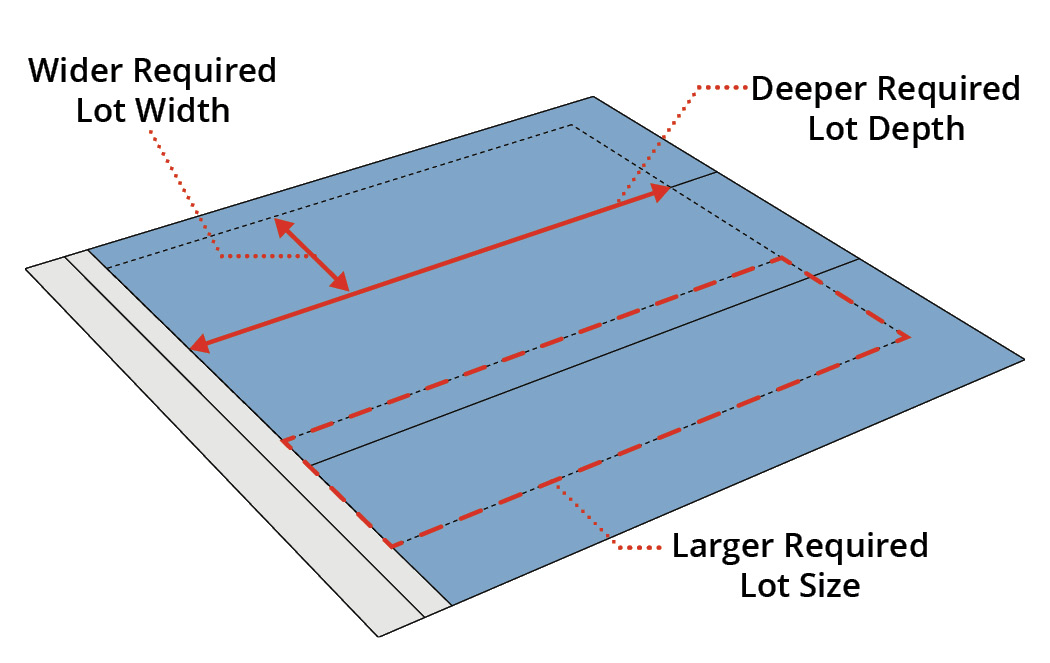
The Single-Family Zoning Analysis aims to identify issues within zoning and outline best practices for making the construction of desired infill housing more practicable.
Featured Work
Phase One of the Single-Family Zoning Analysis was completed in December 2021 and Phase Two is underway.
Background
The Single-Family Zoning Analysis is a project of the Northeast Ohio First Suburbs Consortium in partnership with the Cuyahoga County Land Bank, facilitated by the Cuyahoga County Planning Commission and supported financially by First Federal Lakewood.
Residential infill development is new construction of housing on vacant lots within established neighborhoods, often where homes have been demolished. First Suburbs are often built-out communities with only smaller, scattered vacant lots available, thus infill construction on these lots becomes important to meet housing demand. Infill housing can also bring new investments and opportunities to neighborhoods while diversifying the local housing stock.
This type of development, however, is often difficult, and vacant lots are left unbuilt due to outdated regulations and complicated processes. For example, zoning regulations can often stand in the way of single-family infill construction, as this type of construction occurs in existing neighborhoods on individual lots that can often be smaller and tighter than what zoning requires. Below is an example of this mismatch.
Purpose
The purpose of this initiative is to assist First Suburb communities in expanding single-family infill development by identifying issues within zoning and outlining best practices for making constructing desired infill housing more practicable. This initiative consists of two phases.
Phase One: Zoning Analysis
The aim of the first phase was to identify issues within zoning regulations that can make constructing desired infill housing difficult or cost-ineffective. It was an important start to understanding the state of infill housing development in the First Suburbs, including its challenges and opportunities. Here are the key takeaways:
More information about the initiative's first phase is available on the Phase One page.
Phase Two: Infill Resources
Phase Two directly addresses the concerns and needs identified in Phase One and outlines best practices for improving zoning regulations to make infill more practicable. This includes several resources – both educational material and technical assistance – to improve communities' infill processes and regulations and to help develop a more collaborative partnership between community members, development professionals, and governmental officials.
- Educational Resources: Includes informational booklets, each tailored towards a specific group, to establish a better understanding of single-family infill development, to provide an overview of best practices, and to improve and encourage communication between municipalities and their constituents
- Zoning Code Update Options: A report that offers various code update options and regulatory strategies related to both zoning and administrative policies that communities can employ to reduce barriers to single-family infill
- Design Guidelines Guidebook: A guidebook that provides best practices for developing and administering design guidelines—including considerations, questions, example text, and case studies
- Infill Incentives Options: A report that outlines tools and policies First Suburb communities can use to incentivize new single-family infill
Pilot Program
The Cities of Euclid and South Euclid were selected to participate in a pilot program for zoning updates. The cities shared similar goals of creating opportunities for more housing while preserving the character of the built environment in residential neighborhoods. They chose different zoning methods to help facilitate residential infill, with South Euclid selecting a residential infill overlay and Euclid opting for alterations of existing residential districts. Both updates included similar modifications, including the expansion of permitted principal and accessory uses to include various housing types, the right-sizing of lot area and lot width requirements, the right-sizing of building dimensions such as height and lot coverage, allowing flexibility in front setbacks to preserve neighborhood character, and simplified approval processes for smaller-scale residential infill projects.
Engagement
In Phase One, the 19 First Suburb communities were engaged through a survey, individual interviews, and presentations to gather the most accurate housing data and to better understand the experiences of these communities with single-family infill.
In Phase Two, 23 development professionals were engaged through an online survey, to better understand the benefits and challenges of building single-family infill in the First Suburbs.
Presentation
The project team presented an overview of Phase Two Infill Resources at the meeting of the First Suburbs Consortium on March 3, 2023. The meeting included highlights from the Development Professionals' survey report, the Financial Incentives Options document, the Design Guidelines Guidebook, and the series of educational resources. The project team also provided updates on code rewrites for the cities of Euclid and South Euclid and preliminary work on the Code Update Options document.
Download the presentation
Contact Us
Questions or comments about the Single-Family Zoning Analysis should be directed to:
Mr. Patrick Hewitt, AICP
Planning Manager, Strategy & Development, Cuyahoga County Planning Commission
phewitt@cuyahogacounty.us
or
Ms. Laura Mendez Ortiz, AICP
Planner, Cuyahoga County Planning Commission
lmendezortiz@cuyahogacounty.us
Top photo courtesy of the Cuyahoga County Land Bank





